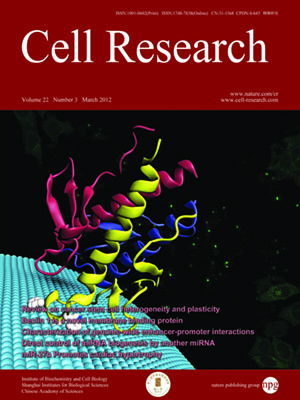
Volume 22, No 3, Mar 2012
ISSN: 1001-0602
EISSN: 1748-7838 2018
impact factor 17.848*
(Clarivate Analytics, 2019)
Volume 22 Issue 3, March 2012: 516-527
ORIGINAL ARTICLES
Cardiomyocyte overexpression of miR-27b induces cardiac hypertrophy and dysfunction in mice
Jian Wang1, Yao Song2, Yan Zhang1, Han Xiao2, Qiang Sun1, Ning Hou1, Shuilong Guo1, Youliang Wang1, Kaiji Fan1, Dawei Zhan3, Lagabaiyila Zha
1State Key Laboratory of Proteomics, Genetic Laboratory of Development and Diseases, Institute of Biotechnology, 20 Dongdajie, Beijing 100071, China
2Institute of Vascular Medicine, Peking University Third Hospital and Key Laboratory of Molecular Cardiovascular Sciences, Ministry of Education, Key Laboratory of Cardiovascular Molecular Biology and Regulatory Peptides, Ministry of Health, Beijing 100191, China
3The First Hospital Affiliated to the Chinese PLA General Hospital, Beijing 100048, China
4Model Organism Division, E-institutes of Shanghai Universities, Shanghai Jiao Tong University, Shanghai 200240, China
Correspondence: Xiao Yang,(yangx@nic.bmi.ac.cn)
Recent studies have begun to reveal critical roles of microRNAs (miRNAs) in the pathogenesis of cardiac hypertrophy and dysfunction. In this study, we tested whether a transforming growth factor-β (TGF-β)-regulated miRNA played a pivotal role in the development of cardiac hypertrophy and heart failure (HF). We observed that miR-27b was upregulated in hearts of cardiomyocyte-specific Smad4 knockout mice, which developed cardiac hypertrophy.
In vitro experiments showed that the miR-27b expression could be inhibited by TGF-β1 and that its overexpression promoted hypertrophic cell growth, while the miR-27b suppression led to inhibition of the hypertrophic cell growth caused by phenylephrine (PE) treatment. Furthermore, the analysis of transgenic mice with cardiomyocyte-specific overexpression of miR-27b revealed that miR-27b overexpression was sufficient to induce cardiac hypertrophy and dysfunction. We validated the peroxisome proliferator-activated receptor-γ (PPAR-γ) as a direct target of miR-27b in cardiomyocyte. Consistently, the miR-27b transgenic mice displayed significantly lower levels of PPAR-γ than the control mice. Furthermore,
in vivo silencing of miR-27b using a specific antagomir in a pressure-overload-induced mouse model of HF increased cardiac PPAR-γ; expression, attenuated cardiac hypertrophy and dysfunction. The results of our study demonstrate that TGF-β1-regulated miR-27b is involved in the regulation of cardiac hypertrophy, and validate miR-27b as an efficient therapeutic target for cardiac diseases.
Cell Research (2012) 22:516-527. doi:10.1038/cr.2011.132; published online 16 August 2011
FULL TEXT | PDF
Browse 2305


